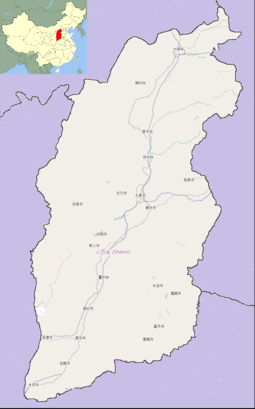Mt. Wutai
| Mount Wutai | |
|---|---|
| 五臺山 | |

Mount Wutai from the air
|
|
| Highest point | |
| Elevation | 3,061 m (10,043 ft) |
| Coordinates | 39°04′45″N 113°33′53″E / 39.07917°N 113.56472°ECoordinates: 39°04′45″N 113°33′53″E / 39.07917°N 113.56472°E |
| Geography | |
|
Wutai County, Shanxi, China
|
|
| Climbing | |
| Easiest route | Hike |
| UNESCO World Heritage Site | |
| Criteria | Cultural: (ii), (iii), (iv), (vi) |
| Reference | 1279 |
| Inscription | 2009 (33rd Session) |
|
[]
|
|
| Mount Wutai | |||||||||||||||||||||||||||
| Chinese | |||||||||||||||||||||||||||
|---|---|---|---|---|---|---|---|---|---|---|---|---|---|---|---|---|---|---|---|---|---|---|---|---|---|---|---|
| Literal meaning | "Five-Terrace Mountain" | ||||||||||||||||||||||||||
|
|||||||||||||||||||||||||||
| Transcriptions | |
|---|---|
| Standard Mandarin | |
| Hanyu Pinyin | Wǔtáishān |
| Wade–Giles | Wu3-t'ai2 Shan1 |
| IPA | [ù.tʰâi ʂán] |
| Wu | |
| Romanization | Ng上-de入-se平 |
| Yue: Cantonese | |
| Yale Romanization | Ngh-tòih Sāan |
| Jyutping | Ng5-toi4 Saan1 |
| Southern Min | |
| Hokkien POJ | Ńgo͘-tâi-soaⁿ |
| Tâi-lô | Ngóo-tâi San |
Mount Wutai, also known by its Chinese name Wutaishan and as Mount Qingliang, is a sacred Buddhist site at the headwaters of the Qingshui in Shanxi Province, China. Its central area is surrounded by a cluster of flat-topped peaks roughly corresponding to the cardinal directions. The north peak (Beitai Ding or Yedou Feng) is the highest (3,061 m or 10,043 ft) and is also the highest point in northern China.
As host to over 53 sacred monasteries, Mount Wutai is home to many of China's most important monasteries and temples. It was inscribed as a UNESCO World Heritage Site in 2009 and named a AAAAA tourist attraction by China's National Tourism Administration in 2007.
Mount Wutai is one of the Four Sacred Mountains in Chinese Buddhism. Each of the mountains is viewed as the bodhimaṇḍa (dàocháng; 道場) of one of the four great bodhisattvas. Wǔtái is the home of the Bodhisattva of wisdom, Mañjuśrī or Wénshū (文殊) in Chinese. Mañjuśrī has been associated with Mount Wutai since ancient times. Paul Williams writes:
Apparently the association of Mañjuśrī with Wutai (Wu-t'ai) Shan in north China was known in classical times in India itself, identified by Chinese scholars with the mountain in the 'north-east' (when seen from India or Central Asia) referred to as the abode of Mañjuśrī in the Avataṃsaka Sūtra. There are said to have been pilgrimages from India and other Asian countries to Wutai Shan by the seventh century.
...
Wikipedia

